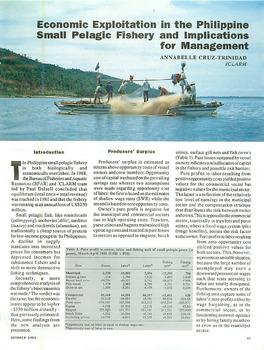Please use this identifier to cite or link to this item:
https://hdl.handle.net/20.500.12348/2934
Economic exploitation in the Philippine small pelagic fishery and implications for the management
| dc.creator | Cruz-Trinidad, A. | |
| dc.date.accessioned | 2019-03-16T07:14:44Z | |
| dc.date.available | 2019-03-16T07:14:44Z | |
| dc.date.issued | 1993 | |
| dc.identifier | na_1417.pdf | |
| dc.identifier.citation | NAGA 16 (4): 13-15 | |
| dc.identifier.uri | https://hdl.handle.net/20.500.12348/2934 | |
| dc.description.abstract | Causes and impact of the Philippine small pelagic fishery sector problems are presented together with the proposed solutions from fisheries and external sectors. The results of the biological and economic analysis of the small pelagic fishery in the Philippines lead to two conclusions: First, small pelagic fish stocks are subjected to levels of fishing effort far beyond that necessary to generate Maximum Sustainable Yield (MSY) let alone Maximum Economic Yield (MEY). Second, and as a result, both sectors are sustaining economic losses (negative economic rents) implying inefficiencies in the use of labor and capital in the small pelagic fishery. Solutions to the problems of overexploitation will rest not only within the fishery sector, but, more importantly, in sectors outside its traditional realm. The underlying causes of fisheries resource over exploitation are also discussed. | |
| dc.format | application/pdf | |
| dc.language | En | |
| dc.publisher | ICLARM | |
| dc.rights | CC BY 4.0 | |
| dc.source | NAGA | |
| dc.title | Economic exploitation in the Philippine small pelagic fishery and implications for the management | |
| dc.type | Journal Article | |
| dcterms.bibliographicCitation | Cruz-Trinidad, A. (1993). Economic exploitation in the Philippine small pelagic fishery and implications for the management. NAGA 16 (4): 13-15 | |
| cg.coverage.country | Philippines | |
| cg.identifier.worldfish | 1417 | |
| cg.subject.worldfish | fisheries management | |
| cg.subject.worldfish | pelagic | |
| cg.contributor.affiliation | ICLARM | |
| cg.identifier.status | Open access | |
| cg.description.theme | Resilient small-scale fisheries | |
| worldfish.location.area | Asia |
